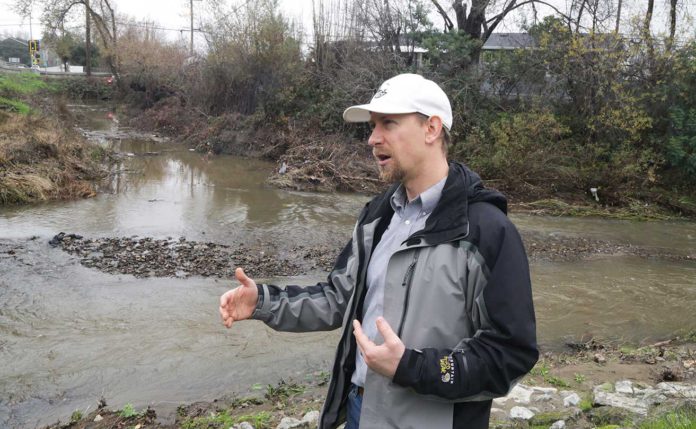
On Jan. 22, as heavy overnight rains drenched the region, Pajaro Regional Flood Control Management Agency (PRFMA) Manager Mark Strudley got up in the middle of the night to make sure that the rivers and streams could handle the surge of water.
They did, and although downed trees and mudslides caused headaches for many mountain residents, this year’s rains have not held a candle to last year’s, when rivers crested and the Pajaro River Levee broke in several places, causing widespread flooding.
Corralitos Creek came up to just 6.5 feet, far below the 12-foot flood stage that occurred last year.
“Everything went fine,” Strudley said as he stood alongside Corralitos Creek, near the bridge at East Lake Avenue.
The moderate rains are good news for Strudley and PRFMA, the agency tasked with overseeing the massive, multi-stage restoration of the Pajaro River Levee system. Heavy rains, he said, would shift efforts to repair work and further delay the long-awaited project.
If the current weather holds up throughout the winter, work could begin this summer on Reach 6 of the project, which runs from the Corralitos Bridge to Green Valley Road.
“It’s still on track, it’s still moving forward,” he said. “We’re still going to have construction items that will be accomplished this calendar year.”
The $599 million Pajaro River Flood Risk Management Project is expected to provide 100-year flood protection to the Pajaro and Watsonville areas, which have been beset by numerous floods since the levee system was built in 1949. It will also protect the surrounding agricultural fields.
County officials and those from the U.S. Army Corps of Engineers—the agency responsible for the work—in November signed an agreement to begin the project. In October 2022, local, state and federal officials gathered to celebrate the full funding of the project.
Strudley says the project will begin with Reach 6, chosen in part because, as the only part of the watershed not protected by a levee, it is more prone to yearly flooding.
The Pajaro area—abutted by its namesake river—will be the focus of the next phase of the project, Strudley said.
In the meantime, beginning Reach 6 is a massive undertaking that will require moving utility poles and lines managed by PG&E, relocating sewer and water lines and moving wells. It will also require raising Corralitos Bridge.
In addition, officials are in talks with property owners, as the levee project will take up more land, Strudley said.
In Watsonville, that means relocating a small apartment complex—and its residents—located near the bridge and directly next to the river.
“It’s hugely complicated,” he said. “This is the most sensitive and challenging issue of this project.”
The project is expected to be complete within five to eight years, a number that decreased with the passage of Assembly Bill 867, which expedites the work by exempting certain aspects of the California Environmental Quality Act (CEQA). The bill, authored by Assemblyman Robert Rivas and Sen. John Laird, also weighs the potential impacts of the project against its environmental and socio-economic benefits.
The legislation fast-tracked work on the Corralitos bridge, Strudley said.
“That legislation is going to shave a year, maybe a year and a half off of the time it would normally take to elevate this bridge,” he said. “That was a huge win for this project.”
A final draft of the design by the U.S. Army Corps of Engineers—the agency performing the work—will be released in February.
Strudley says that PRFMA is utilizing “engineering with nature features” into the project, which includes enhancing habitats and improving groundwater recharge.
That also includes working with nature when applicable. The design was recently tweaked, he said, to save two large heritage sycamore trees.
Repairs of the damage caused by last year’s storms are largely done, Strudley says, with a levee breach under Highway 1 expected to wrap up this month, and one closer to the coast to be done in April.
“We have good consultants, we have a good team, we have great folks working with us at the Army Corps,” Strudley said. “And we have great really supportive people from the Department of Water Resources working with us at the state, so for the past few years, all the stars are still aligned.”











